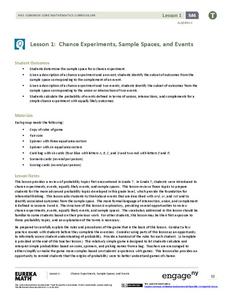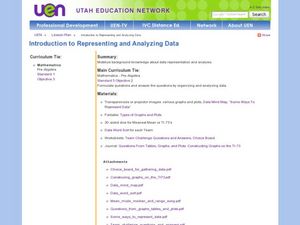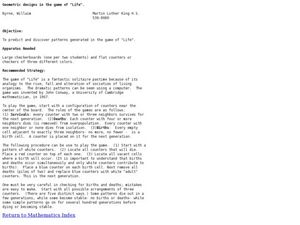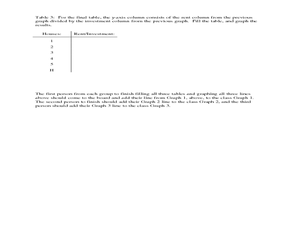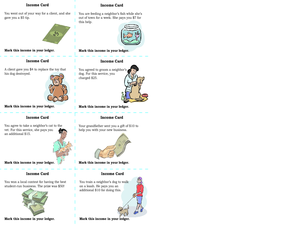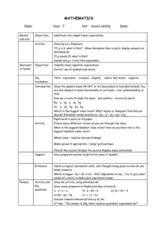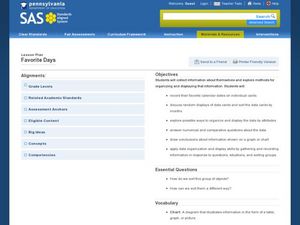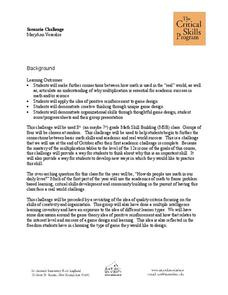National Security Agency
Are You Game? A Lesson Connecting Fractions and Probability
Exactly how fair are the board games children grow up playing? Young mathematicians investigate this questions as they work their way through this five-lesson series on basic probability.
Math Solutions
Factor Game
Learning about factors and multiples is all fun and games with this simple math activity. The activity begins with the teacher and class playing the Factor Game together as students figure out the rules and uncover key...
EngageNY
Chance Experiments, Sample Spaces, and Events
Want a leg up on the competition? Show classes how to use mathematics to their advantage when playing games. Learners calculate probabilities to determine a reasonable scoring strategy for a game.
EngageNY
Recursive Formulas for Sequences
Provide Algebra I learners with a logical approach to making connections between the types of sequences and formulas with a activity that uses what class members know about explicit formulas to develop an understanding of...
Curated OER
The Games Robots Play
Students learn about how robots are programmed to play games. They then construct robot applications (basic computer codes) for playing tic-tac-toe comprised of if-then logic sequences. Students then compete in teams using their...
Curated OER
Introduction to Representing and Analyzing Data
Represent data graphically. Allow your class to explore different methods of representing data. They create foldables, sing songs, and play a dice game to reinforce the measures of central tendency.
National Security Agency
A Balancing Act: Solving Multi-Step Equations
Wow! Put on that thinking cap and solve multi-step equations. To solve equations, learners review the use of the distributive property and combining like terms. This three-day lesson comes with about 20 pages of worksheets, warm-ups,...
Curated OER
Sort It Out
Elementary schoolers engage in a game of logical reasoning called Secret Sort. A Venn diagram is used as a way to sort objects. This resource would be a great way to introduce the Venn diagram (maybe the most famous, and most-useful...
Curated OER
Introduction to Polar coordinates
The class practices plotting points in a Cartesian coordinate system and a Polar coordinate system. They convert from one system to the other to get coordinates to plot. Then they play a Tic-Tac-Toe or Connect Four game to have a...
Curated OER
Geometric Designs in the Game of "Life"
Students play a game to discover simple patterns. For this geometric designs lesson, students use a game board and counters to represent survivals, deaths, and births. They explore simple patterns for several generations.
Curated OER
Monopoly Graphs
Learners relate the concepts of linear functions to the game of monopoly. In this algebra lesson, students solve problems with ratio and proportion. They collect data and graph it.
Curated OER
Income and Expenses
Students discuss income and expenses. In this lesson plan on money, students define income and expenses, after whith they keep track of their income and expense transactions on a basic ledger.
Curated OER
Tic-Tac-Toe
Students investigate finite mathematics using a flow chart. In this algebra lesson plan, students investigate logic and strategies using flowcharts. Students compete against each other using different approaches to playing the game.
Curated OER
Acting Like a Hog
Students explore game theory. In this secondary mathematics lesson, students plat the game of HOG using dice and explore the optimal strategies. Students play the game three ways: any number of dice, a fixed number of...
Curated OER
Shape Hunt
Young scholars explore two-dimensional and solid shapes. In this shapes and patterns geometry lesson, students work with a partner to create identifiable objects using tangrams. Young scholars describe the attributes of their shape and...
Curated OER
A Room Full of Colors and Shapes
Students explore their new classroom with this hunting and matching game. In this early childhood problem solving lesson, students use observation and matching skills as they hunt for pre-cut shapes around the classroom.
Curated OER
Substitute into Simple Expressions
Learners simplify simple equations. Using a maze game, young mathematicians speculate about the size of different algebraic values and what other equivalent expressions might look like. It is a nice beginning activity for introducing...
Curated OER
More Games on Graphs
Students investigate various games employing graphs as game boards. In this game theory lesson, students problem solve through the use of graphs. The lesson is a list of both indoor and outdoor games to...
Curated OER
Favorite Days
Students collect and organize data about themselves. In this data analysis instructional activity, students discuss their favorite calendar dates and explore ways to display the data.
Curated OER
Ordered Pairs on a Coordinate Plane
Seventh graders identify the quadrants and axis of a coordinate plane. In this algebra instructional activity, 7th graders discover the correct way to graph using the coordinate plane. They discuss the relationship between x and y...
Curated OER
Scenario Challenge
Students apply their knowledge of math to the real world. In this algebra lesson, students explore different way to incorporate math topics into the real world. They create a score or progress sheet to mark their progress.
Curated OER
Probability
Sixth graders explore theoretical and experimental probability. In this probability lesson, 6th graders participate in several hands-on activities involving the comparison of theoretical probability to the actual results. Games include...
Pennsylvania Department of Education
Fraction Strips
Students explore number sense by participating in a class fraction game. In this number value instructional activity, students utilize strips of paper with fractions written on them and conduct a trivia game in which teams challenge each...
Curated OER
Quadrilateral Attributes
Students classify quadrilaterals. In this quadrilateral lesson, students identify the characteristics of quadrilaterals. They write their findings in a journal. Students use geoboards to create quadrilaterals from given descriptions.


